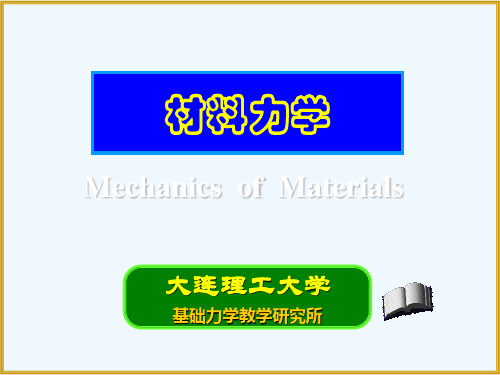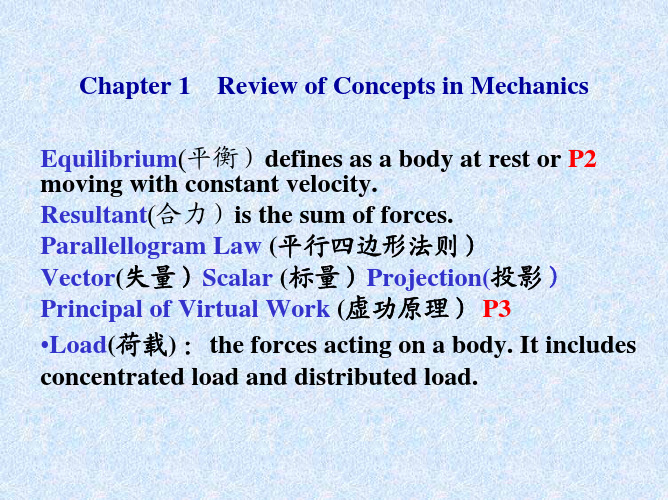Mechanics(1)
- 格式:ppt
- 大小:5.74 MB
- 文档页数:10


工程管理专业本科生培养方案一、培养目标本专业培养具备管理学、经济学和土木工程技术基本知识,掌握现代管理科学理论、方法和手段,熟悉相关法规,能在国内外工程建设领域从事全过程项目策划、管理和实务运作;以及房地产投资与经营管理、物业管理等方面的复合型高级管理人才。
二、培养基本规格要求(一)品德和政治思想要求热爱社会主义祖国、拥护中国共产党的领导;坚持四项基本原则,努力学习马列主义、毛泽东思想和邓小平理论;熟悉国家有关方针、政策和法规;爱祖国、爱劳动、遵纪守法;团结同志、关心集体,政治思想素质高;热爱专业,有较强的事业心、责任感和勇于开拓创新精神;品行端正、道德品质优良。
(二)主要知识和能力要求以马列主义、毛泽东思想基本原理以及邓小平理论为指导,通过四年的学习,掌握本专业的基本理论、基本知识和基本技能。
较系统地掌握必要的经济管理科学的基本理论、建筑工程技术的基本知识;了解本专业范围内科学技术的新发展;掌握本专业所必需的现代数理方法,受到必要的技术经济分析能力和决策能力的训练,以及建筑施工管理、工程概预算方面的基本训练。
具有独立获取新知识的意识和能力;具有初步的投资项目管理能力,较强的计算机应用能力,结合所学知识解决理论与实际问题的能力,掌握一门外语。
具体是:1.掌握工程管理的组织理论、计划方法和实施目标控制的基本技能;掌握建设投资经济活动的基本规律和技术经济评价分析与项目决策的原理、方法;2.熟悉建筑土木工程技术知识;熟悉工程项目建设的方针、政策和法规;熟悉房地产基本制度与政策、房地产金融、投资、估价和经纪等基本业务;3.了解国内外工程管理的理论和实践的发展动态;4.具有运用计算机辅助解决工程管理问题的能力;具有工程造价管理(或建筑工程概预算)能力;具有从事工程项目决策与全过程管理的基本能力;具有初步的房地产投资与经营管理能力;具有准确、精练的口头与文字表达能力;外语达到四级以上,具有阅读和翻译专业书刊的能力和较强的听说能力。

I. Theoretical Mechanics理论力学Gravitational Force, Gravity重力Concurrent Force汇交力, Coplanar Force共面力Force, Torque / Moment扭矩, Couple 约束力,反应,被动力,内力Constraint Force, Reaction, Passive Force, Internal/External Force 静力学直角坐标分量,合力,平行四边形准则Rectangular Components, Resultant Force, Parallelogram Law 1. Statics Composition of Force力的合成, Free Body Diagram隔离体Vector (Magnitude, Direction)矢量, Scalar标量静力平衡平衡方程平衡条件Net Force = 0Static Equilibrium, Equation of Equilibrium, Conditions for EquilibriumNet Torque/Moment = 0Rectilinear MovementMotion of Particle粒子运动Curvilinear Movement运动学 Translation平移2. Kinematics Motion of Rigid Body刚体运动Rotation扭转Linear线性的Velocity速度, Acceleration加速度Angular有角的Momentum, Kinetic Energy, Potential Energy动量,动能,势能动力学Moment of Inertia (Rectangular, Polar), Radius of Gyration惯性矩,回转半径3. Dynamics, Kinetics Centroid (Center of Mass/Gravity)中心Vibration, Oscillation (Free/Forced/Damped/Undamped)振动Simple Harmonic Motion, Period, Frequency简谐振动,周期,频率Pendulum, Centrifugal/Centripetal Force钟摆,离/向心力II. Mechanics of Materials材料力学材料强度 Compressive, Compression压缩1. Strength of Materials Tensile, Tension (Elongation, Extension)伸长Shear, Shearing剪切Linear, Hooke’s LawElastic弹性, Elasticity Non-linearViscoelasticity, Pseudo-elasticity, Super-elasticity粘弹性,拟弹性,超弹性应力应变关系塑性 Perfect Plasticity理想塑性2. Stress-Strain Relation/Behavior Plastic, Plasticity Viscoplasticity, Viscosity黏性, Creeping徐变, RelaxationBrittle脆性, Ductile柔性Work Hardening/Softening, Strain Hardening/Softening弹性模量,弹性系数 Young’s Modulus = Axial Stress / Axial Strain杨氏模量3. Modulus of Elasticity, Elastic Modulus Shear Modulus = Shear Stress / Shear Strain剪切模量Bulk Modulus = Volumetric Stress / Volumetric Strain体积弹性模量破坏理论,失效准则,屈服准则 Maximum Principal Stress Theory最大应力准则4. Failure Theory, Failure Criteria, Yield Criteria Shear Stress TheoryMohr-Coulomb Theory库伦理论Shear Force剪力, Bending Moment弯矩, Flexural Load弯曲荷载梁 Bending Stress弯曲应力, Normal Stress正应力, Shear Stress剪应力 (Horizontal/Longitudinal, Vertical/Transverse)5. Beam Neutral Axis中性轴, Flexure屈曲, Deflection挠曲Cantilever Beam悬臂梁, Simply Supported Beam简支梁, Pin-end, Fixed End固定端Uniformly/Linearly Distributed Load均布荷载, Concentrated Load集中荷载Buckling屈曲系数, Euler’s Equation欧拉方程6. Column 长细比,有效长度,临界荷载,偏心率Slenderness Ratio, Effective Length, Critical Load/Stress, Eccentricity RatioTension弹力, Compression压缩, Uniaxial/Axial Load单轴荷载7. Shaft杆, Rod长杆, Bar Inner/Outer Diameter内/外径Torsion扭转, Torque扭矩, TwistingRadial Distance辐射距离平面应变平面应力双向应力(单轴,三轴)应变能最大/小主应力8. Plane Strain, Plane Stress, Biaxial Stress (Uniaxial, Triaxial), Strain Energy, Major (Minor) Principal Stress Deformation变形, Displacement位移, Deflection偏向Stiffness, Rigidity刚度, Hardness硬度, Flexibility弹性, ComplianceDynamic Loading动力荷载, Cyclic/Fluctuating Loading脉冲荷载, Fatigue疲劳度Thermal Stress热应力/Strain/Deformation, Coefficient of Thermal Expansion热膨胀系数Factor of Safety安全系数, Safety FactorLimit State Design极限状态设计 (Ultimate Limit State极限状态, Serviceability Limit State正常使用极限状态), Probabilistic Design概率设计III. Structural Mechanics, Structural AnalysisRod, Shaft, Bar构件Beam, Girder1. Structural Element Column, PillarPlate, Shell, MembraneShear Wall, Shear Panel2. Truss构架, 3-hinge Arch, Rigid Frame刚性框架 (Joint节点, Pin-Joint, Hinge, Node)3. Statically Determinate静定, Statically Indeterminate超静定, Degree of Static Indeterminacy, N-fold Statically Indeterminate, Degree of Freedom自由度虚功原理 Virtual Displacement, (Matrix) Displacement Method, Stiffness Method4. Virtual Work Principle Virtual Force, (Matrix) Force Method, Flexibility MethodFinite Element MethodIV. Theory of Elasticity(Differential) Equilibrium Equation, Physical Equation, Compatibility/Geometrical EquationBoundary Conditions。



常用物理英语词汇(全)力学(Mechanics)1. Force(力)2. Acceleration(加速度)3. Momentum(动量)4. Kinetic Energy(动能)5. Potential Energy(势能)6. Gravity(重力)7. Friction(摩擦力)8. Torque(扭矩)9. Angular Momentum(角动量)10. Work(功)热学(Thermodynamics)11. Temperature(温度)12. Heat(热量)13. Internal Energy(内能)14. Entropy(熵)15. Boyle's Law(波义耳定律)16. Charles's Law(查理定律)17. GayLussac's Law(盖吕萨克定律)18. Ideal Gas Law(理想气体定律)19. First Law of Thermodynamics(热力学第一定律)20. Second Law of Thermodynamics(热力学第二定律)电磁学(Electromagnetism)21. Electric Charge(电荷)22. Electric Field(电场)23. Magnetic Field(磁场)24. Current(电流)25. Voltage(电压)26. Resistance(电阻)27. Capacitance(电容)28. Inductance(电感)29. Ohm's Law(欧姆定律)30. Ampère's Law(安培定律)光学(Optics)31. Light(光)32. Refraction(折射)33. Reflection(反射)34. Diffraction(衍射)35. Interference(干涉)36. Polarization(偏振)37. Lens(透镜)38. Prism(棱镜)39. Spectrum(光谱)40. Wave Optics(波动光学)现代物理(Modern Physics)41. Quantum Mechanics(量子力学)42. Relativity(相对论)43. Photon(光子)44. Electron(电子)45. Proton(质子)46. Neutron(中子)47. Quark(夸克)48. Black Hole(黑洞)49. Higgs Boson(希格斯玻色子)50. String Theory(弦理论)这些词汇仅为物理学中常用术语的一小部分。
费恩曼的物理学讲义第一卷
费恩曼的物理学讲义是一系列物理学教材,由美国物理学家理
查德·费曼(Richard Feynman)编写。
其中,第一卷是《费恩曼物
理学讲义第一卷,力学》(The Feynman Lectures on Physics, Volume 1: Mainly Mechanics, Radiation, and Heat)。
这本书主要涵盖了力学、辐射和热学等内容。
费恩曼以其独特
的教学风格和生动的讲解方式,将复杂的物理概念解释得浅显易懂,深受学生和物理爱好者的喜爱。
在《费恩曼物理学讲义第一卷,力学》中,费恩曼首先介绍了
物理学的基本原理和方法,然后详细探讨了力、运动、动量、能量、引力、静力学、动力学等力学的基本概念和定律。
同时,他还涉及
了流体力学、弹性力学和振动等内容。
费恩曼在书中注重培养读者的物理直觉和思维方式,通过丰富
的例子和实验来帮助读者理解物理学的基本原理。
他还引入了一些
历史背景和趣闻轶事,使得内容更加生动有趣。
这本教材对于物理学学习者来说是一本非常重要的参考书。
它
不仅可以帮助初学者建立坚实的物理基础,还可以帮助高级学习者深入理解和应用物理学的各个领域。
总之,费恩曼的物理学讲义第一卷是一本涵盖力学、辐射和热学等内容的经典物理学教材。
它以其独特的教学风格和深入浅出的讲解,帮助读者全面理解物理学的基本原理和概念。
无论是对于学生还是物理爱好者,这本书都是一本不可或缺的参考书。
Section A Velocity and Acceleration(Chapter 1)1.A man runs in a straight line. He passes through a fixed point A with constantvelocity 7ms_1at time t = 0. At time t s his velocity is v ms_1. The diagram shows the graph of v against t for the period 0 ≤t ≤ 40. (02w)(i) Show that the man runs more than 154m in the first 24 s. [2](ii)Given that the man runs 20m in the interval 20 ≤t ≤ 24, find how far he is from A when t = 40.[2]2The diagram shows the velocity-time graphs for the motion of two cyclists P and Q, who travel in the same direction along a straight path. Both cyclists start from rest at the same point O and both accelerate at 2ms−2 up to a speed of 10ms−1. Both then continue at a constant speed of 10ms−1.(03s)Q starts his journey T seconds after P.(i) Show in a sketch of the diagram the region whose area represents thedisplacement of P, from O,at the instant when Q starts. [1]Given that P has travelled 16m at the instant when Q starts, find(ii) the value of T, [3](iii)the distance between P and Q when Q’s speed reaches 10ms−1. [2]3A boy runs from a point A to a point C. He pauses at C and then walks back towardsA until reaching the point B, where he stops. The diagram shows the graph ofv against t, where v ms−1 is the boy,s velocity at time t seconds after leavingA. The boy runs and walks in the same straight line throughout. (04s)(i) Find the distances AC and AB. [3](ii) Sketch the graph of x against t, where x metres is the boy,s displacement from A. Show clearly the values of t and x when the boy arrives at C, when he leaves C, and when he arrives at B. [3]4Particles P and Q start from points A and B respectively, at the same instant, and move towards each other in a horizontal straight line. The initial speeds of P and Q are 5ms−1 and 3ms−1 respectively. The accelerations of P and Q are constant and equal to 4ms−2 and 2ms−2 respectively (see diagram).(04w)(i) Find the speed of P at the instant when the speed of P is 1.8 times the speedof Q. [4](ii) Given that AB = 51 m, find the time taken from the start until P and Q meet.5The diagram shows the velocity-time graph for a lift moving between floors ina building. The graph consists of straight line segments. In the first stagethe lift travels downwards from the ground floor for 5 s, coming to rest atthe basement after travelling 10 m. (05s)(i) Find the greatest speed reached during this stage. [2]The second stage consists of a 10 s wait at the basement. In the third stage,the lift travels upwards until it comes to rest at a floor 34.5m above the basement,arriving 24.5 s after the start of the first stage. The lift accelerates at 2ms−2 for the first 3 s of the third stage, reaching a speed of V ms−1. Find(ii) the value of V, [2](iii) the time during the third stage for which the lift is moving at constant speed, [3](iv) the deceleration of the lift in the final part of the third stage. [2]6 A car travels in a straight line with constant acceleration a ms−2. It passesthe points A, B and C, in this order, with speeds 5ms−1, 7ms−1and 8ms−1respectively.The distances AB and BC are d1 m and d2 m respectively.(i) Write down an equation connecting (a) d1 and a,(b) d2 and a. [2](ii) Hence find d1 in terms of d2. [2]7、 The diagram shows the displacement-time graph for a car’s journey. The graphconsists of two curved parts AB and CD, and a straight line BC. The line BC isa tangent to the curve AB at B and a tangent to the curve CD at C. The gradientof the curves at t = 0 and t = 600 is zero, and the acceleration of the car is constant for 0 < t < 80 and for 560 < t < 600. The displacement of the car is 400m when t = 80. (05w)(i) Sketch the velocity-time graph for the journey. [3](ii) Find the velocity at t = 80. [2](iii) Find the total distance for the journey. [2](iv) Find the acceleration of the car for 0 < t < 80. [2]8The diagram shows the velocity-time graph for the motion of a small stone which falls vertically from rest at a point A above the surface of liquid in a container.The downward velocity of the stone t s after leaving A is v ms−1. The stone hits the surface of the liquid with velocity7ms−1when t = 0.7. It reaches the bottom of the container with velocity 5ms−1 whent = 1.2. (06s)(i) Find(a) the height of A above the surface of the liquid,(b) the depth of liquid in the container.[3](ii) Find the deceleration of the stone while it is moving in the liquid. [2](iii)Given that the resistance to motion of the stone while it is moving in the liquid has magnitude 0.7N, find the mass of the stone. [3]9 A train travels from A to B, a distance of 20 000m, taking 1000 s. The journeyhas three stages. In the first stage the train starts from rest at A andaccelerates uniformly until its speed is V ms−1. In the second stage the traintravels at constant speed V ms−1 for 600 s. During the third stage of the journeythe train decelerates uniformly, coming to rest at B. (08w)(i) Sketch the velocity-time graph for the train’s journey. [2](ii) Find the value of V. [3](iii) Given that the acceleration of the train during the first stage of thejourney is 0.15 ms−2, find the distance travelled by the train during thethird stage of the journey. [4]10A train starts from rest at a station and travels in a straight line until itcomes to rest again at the next station. The displacement-time graph above refersto the journey. (01w)(i) The speed of the train is constant from t = 120 to t = 440. Find this speed.[2](ii) Given that the acceleration of the train is constant from t = o tot= 120 and from t = 440 to t = 480, make a sketch of the velocity-timegraph for the journey, showing the maximum speed of the train. [3]。